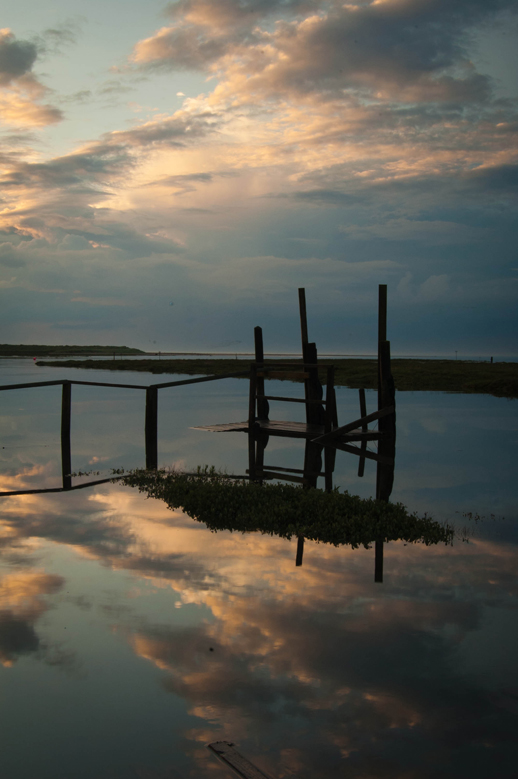Words and pictures by Danny Adcock.
There are certain places along the North Norfolk coast – Thornham, Brancaster, and Burnham Overy Staithe amongst others – where it is wise to know the time and state of the tide before you leave your car in one of the creek-side car parks. A big spring tide will often flood not only the car parks, but the roads leading to them, and insurance companies take a dim view of any car that has had sea-water in it. And don’t be fooled into thinking that if it’s not Spring you’ll be OK; spring tide is a bit of a misnomer. They actually occur twice every month – at both the new moon and the full. Neap tides, which occur at the opposite stage in the tidal cycle to spring tides, get their name from an old English word as far as I’m aware, though I believe its origin is a little uncertain. As is why spring tides are so named. It may be something to do with the fact that the very highest spring tides are at the new or full moon nearest the equinoxes; one of which happens to be the 21st of March – Spring – or as simple as spring meaning where water wells up from.
At Thornham the flood, or incoming tide, begins far out on the sands. There must be a point, an exact second where the ebb, or outgoing tide, stops, and the flood tide begins; an unnoticed fraction of time governed by the gravitational pull of the moon when the sea ceases retreating, and turns to face the land again. Still far out from the beach it begins to pick up pace; filling the ripples it left in the sand on its last visit with foam-flecked wavelets, and eradicating the footsteps of bird and dog-walker alike. As it advances it picks up pace, greedily filling the channels between sandbars that it and the wind are constantly changing. The tide starts to make its way up the deeper channel that leads into Thornham harbour about three hours before it peaks. A lugworm or peeler crab cast into this channel has often rewarded me with a shimmering sea bass. By the time the tide reaches the marshes it’s racing unstoppably; picking up the buoys that mark the channel and leaving them bobbing frantically in its wake. Through the marsh it continues unfettered. Pulsing through the arteries of this landscape, engorging gullies, spilling over into gutters, and deep-hidden mud-courses like blood from a heart and lungs flowing through a web of tiny capillaries.
At Thornham harbour – really just a few boats moored to some rather ramshackle looking landing stages – the marshes stretch either side of the road that leads to a small raised car park once the site of a large grain store. The channel was deeper then, and much larger boats than the few pleasure craft now here could access this far inland. Not so long ago farming supported most of the communities near here, and the ability for fairly substantial vessels to be able to transport the crop pretty much anywhere must have been invaluable.
If you don’t mind getting muddy – and I do mean muddy – you can gather a crop of your own here; samphire (pronounced sampha by the way) grows extensively in the marshes all along this coast. I like mine boiled, with lots of black pepper and a poached egg on top.
For me a really high tide is a magical thing, and especially if it coincides with that unique stillness you sometimes get at dusk, but particularly at dawn; when it seems that there has never been, nor ever will be again, such a troublesome thing as the wind. There’s an almost touchable anticipation to the landscape, a collective intake and holding of breath. On those rare mornings I like to be either fishing, or taking photographs. Longer ago than the organised farming of a few-hundred-or-so-years-ago a high tide would have been a significant event for coastal communities, meaning fish came closer to the shore in bigger numbers and, on the correspondingly lower ebb, perhaps uncovered beds of shellfish that would normally be inaccessible. Unfortunately, high tides in the modern era are often associated with disaster; the catastrophic combination of a spring tide and huge North Sea storm of January 1953 killed more than three hundred people along the East Anglian coast between Lincolnshire and Essex, while Holland suffered nearly two thousand fatalities.
On a high spring tide once the sea has flooded the marshes and the creeks of Thornham it begins to spill over the road; the boats appear to be moored to randomly protruding bits of wood once it engulfs the landing stages. If it is a still morning the sea is like glass; people come to look at the seeming emptiness of the sea, but on the land. Some are surprised. Driving down to the harbour they find, instead of a road, the sea. They stop, get out of their cars, and stare bemusedly before reversing back the way they came. What’s called the old coal barn is marooned high and dry, and the tide inches malevolently further and further up the road. In the last hour of the flood the tide slows down, and once again there’s an imperceptible moment when the sea is defeated by the permanence of the land, as it turns to begin creeping back the way it came. It slides from the road back into the creeks leaving stray locks of weed and sea-scum here and there. Its retreat gradually speeds up until it’s flowing out as fast out as it came in. The mullet that forage deep inland follow it out, the crabs skulk back to their mud-filled lairs, and the scores of waders – redshank, curlew, godwit, avocet – track the tide-line out until, once more, the tide turns and begins again its age-old assault on the land.

